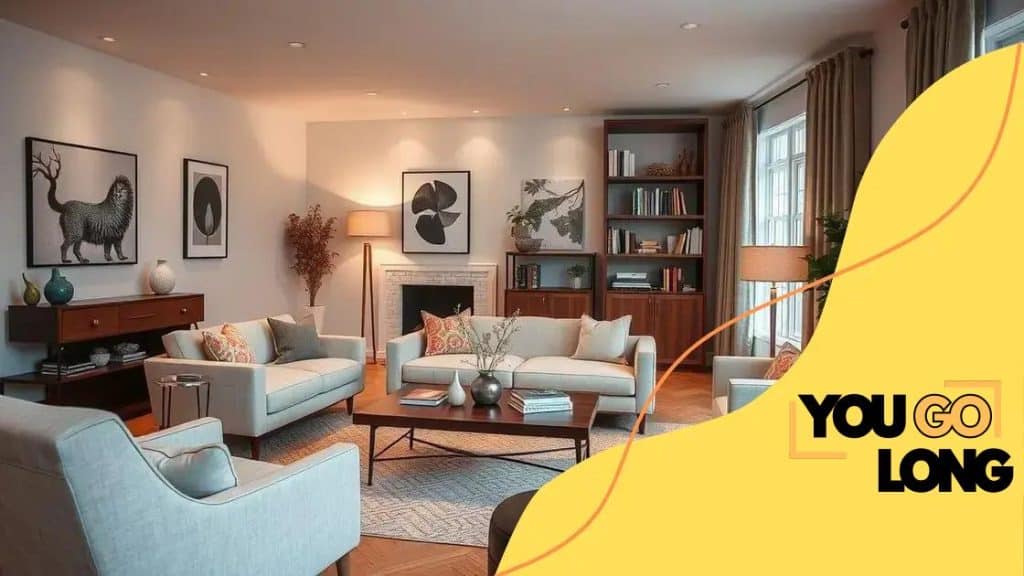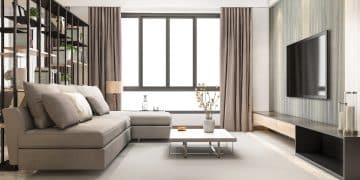How to mix modern and traditional decoration styles

Advertisement
Mixing modern and traditional decoration styles involves balancing complementary colors, carefully curating accessories, and using focal points to create a cohesive and inviting space that reflects your unique taste.
Have you ever wondered how to mix modern and traditional decoration styles? How to mix modern and traditional decoration styles can bring a fresh and unique feel to your space, making it feel inviting yet sophisticated. Let’s explore how you can achieve this blend effortlessly.
Understanding modern decoration elements
Understanding modern decoration elements involves knowing the key features that define this style. Modern design is all about simplicity and functionality, emphasizing clean lines and open spaces. Incorporating these elements into your home can create a sleek and inviting atmosphere.
Key Characteristics of Modern Decoration
Modern decoration focuses on several vital characteristics that set it apart from traditional styles. It promotes minimalism, ensuring that each piece of decor serves a purpose, while also contributing to the aesthetic appeal of the space.
Advertisement
- Simplicity: Modern design embraces simplicity, with less clutter and fewer embellishments.
- Neutral Color Palette: Common colors include whites, grays, and blacks, often paired with a pop of color to add interest.
- Functional Furniture: Furniture is sleek with geometric shapes, keeping comfort and utility in mind.
Another significant aspect of modern decoration is the use of natural materials. Elements like wood, glass, and metal are frequently employed, adding warmth and texture to the environment. Natural light is also essential, making large windows a popular feature in modern homes. This connection to the outdoors enhances the feeling of spaciousness.
Blending Styles
When mixing modern with traditional elements, focus on preserving the essence of both styles. For instance, a modern sofa can look striking next to a vintage coffee table. This creates a unique conversation piece, merging old and new in a delightful way.
Don’t forget to incorporate accessories that reflect both styles, like modern art pieces displayed against traditional wallpaper or cozy fabrics. By thoughtfully combining these decor elements, you create a visually appealing space that is both functional and inviting.
Advertisement
Exploring traditional design features
Exploring traditional design features helps us appreciate the timeless beauty of classic decor. Traditional design is characterized by its warmth, rich fabrics, and detailed craftsmanship. Understanding these elements can enhance how you blend them with modern styles.
Core Elements of Traditional Design
One striking aspect of traditional design is its emphasis on symmetry and balance. Rooms are often designed to create a harmonious look, with furniture and decor strategically placed. This feeling of order creates a cozy, inviting atmosphere.
- Rich Color Palettes: Traditional rooms often feature deep, warm colors like burgundy, navy, and forest green.
- Intricate Patterns: Fabrics like brocade and damask add texture and elegance.
- Classic Furniture: Antique or vintage pieces, such as ornate chairs and wooden tables, are common.
Additionally, traditional design places a strong focus on details. Crown molding, baseboards, and wainscoting are often used to elevate the aesthetic. These architectural elements add depth and character, enhancing the overall charm of the space.
Incorporating Tradition into Modern Spaces
Mixing traditional design with modern styles can create a beautiful balance. For example, a classic chandelier can add elegance to a sleek, modern dining room. When pairing the two styles, aim for a cohesive look that respects the integrity of both.
Another great way to blend these styles is by using traditional textiles in modern furniture. A contemporary sofa topped with patterned throw pillows can bridge the gap between the two styles, making your space feel both current and timeless.
Finding balance between styles

Finding balance between styles is an essential part of creating a harmonious space. When combining modern and traditional decoration styles, a thoughtful approach can lead to an inviting and unique environment. The key is to blend both aesthetics without overwhelming the space.
Establishing a Focal Point
Begin by establishing a focal point in the room. This could be a stunning piece of modern art or a vintage chandelier. The focal point should draw the eye and set the tone for the entire space. From there, arrange your furniture and decor around it.
- Choose Complementary Colors: Identify a color palette that incorporates both modern and traditional shades. Neutrals can serve as a great base.
- Mix Textures: Combine sleek surfaces with rich fabrics to create depth.
- Utilize Scale: Balance larger traditional pieces with smaller modern items to maintain proportion.
Another effective technique is to use transitional pieces that naturally bridge the two styles. For example, a traditional wooden coffee table can pair beautifully with a modern sectional sofa. This type of combination creates a dialogue between the old and the new, enriching the overall design.
Accessorizing Thoughtfully
Accessorizing is another way to find balance. Integrate decorative elements from both styles to enhance the mix. A few modern vases can sit atop a traditional sideboard, making the space cohesive. These accessories should not feel random; instead, they should tell a story that connects both design philosophies.
Lighting offers another opportunity to merge styles. Consider modern light fixtures with classic lines or vintage lamps paired with contemporary shades to achieve the desired balance. Ultimately, finding balance between styles is about creating a space where both can coexist while complementing each other.
Color palettes that work well together
Color palettes that work well together can enhance the beauty of your home, especially when mixing modern and traditional styles. A well-thought-out palette brings unity and flow to your space, making it feel cohesive.
Choosing a Base Color
Start by selecting a base color that will anchor the room. Neutral shades like beige, gray, or white work well, as they allow you to introduce more dynamic colors later.
- Beige: A warm neutral that creates a cozy atmosphere.
- Gray: A versatile option that pairs well with both warm and cool tones.
- White: A crisp choice that maximizes light and makes the space feel larger.
Next, identify accent colors that complement your base. For a modern twist, think about bold shades like teal, mustard yellow, or deep blue. These colors can add a contemporary feel to traditional elements, making the room feel fresh.
Harmonizing Warm and Cool Tones
To find balance, mix warm and cool tones thoughtfully. Warm colors like red, orange, and yellow can create a vibrant and welcoming feel, while cool colors such as blue, green, and purple evoke calmness.
Using both in your palette can lead to a dynamic environment. For instance, pairing a rich navy sofa with warm mustard pillows can create striking contrast while still feeling harmonious.
Creating Depth with Shades and Tints
Another effective method is to play with shades and tints of your chosen colors. For example, a muted green can serve as an excellent backdrop for brighter flowers or art pieces. These variations allow you to maintain a cohesive palette while introducing visual interest.
Remember, testing color combinations in small sections helps to visualize how they interact with each other. Use swatches or paint samples to see how different lighting affects your choices.
Accessorizing with a mix of old and new
Accessorizing with a mix of old and new can elevate your home decor and create a unique aesthetic. By combining vintage finds with contemporary pieces, you bring personality to your space and storytelling elements.
Understanding the Balance
When accessorizing, aim for a balance that feels intentional rather than random. Start with a few key items from each style. This approach helps ensure that both modern and traditional pieces complement each other.
- Antique Mirrors: Use a vintage mirror as a focal point, which can reflect light and expand the visual space.
- Modern Vases: Pair a sleek, modern vase with fresh flowers on a traditional wooden table.
- Throw Pillows: Mix patterned, traditional pillows with solid colored, modern ones on a couch.
Another effective method is to choose accessories that share common colors or materials. This creates a visual connection between the old and new items, helping them feel cohesive in the space.
Creating Visual Interest
Accessorizing with a mix of old and new not only showcases your style but also adds layers of texture. Think about including items like a contemporary sculpture next to an ornate, vintage lamp. This juxtaposition creates visual interest and stimulates conversation.
Gallery walls are a great canvas for this mix. Pair contemporary art prints with traditional frames for an eclectic display. The contrast of new and old art forms can enhance the appeal of your living space.
Thoughtful Placement
Placement is key in achieving a successful mix. Place traditional items in unexpected areas, like a modern bathroom featuring a classic clock. This surprise element can make your decor feel more curated.
Additionally, consider the scale of your accessories. Large vintage pieces may benefit from minimal nearby modern designs. Such contrasts ensure that each element stands out without overwhelming the viewer.
In conclusion, successfully mixing modern and traditional decoration styles comes down to understanding balance and harmony. By carefully blending these elements, you can create a space that feels both inviting and stylish. Remember to choose complementary color palettes, thoughtfully curate your accessories, and maintain a sense of cohesion. With these tips, your home can reflect your unique taste while showcasing the best of both worlds. Enjoy the process of decorating and let your personal style shine!
FAQ – Questions about Mixing Modern and Traditional Decoration Styles
How can I successfully mix modern and traditional styles in my home?
Start by selecting a cohesive color palette and incorporating accessories from both styles to create balance and harmony throughout the space.
What are some key elements to consider when accessorizing?
Focus on establishing a focal point, using complementary colors, and ensuring that the scale of items is appropriate to the room’s dimensions.
Can old and new decor really work together?
Yes, blending vintage and modern pieces adds character and uniqueness to your decor, creating an inviting and visually stimulating environment.
What types of accessories should I use?
Incorporate a mix of items like vintage mirrors, modern vases, and contemporary art in classic frames to bridge the gap between styles effectively.





